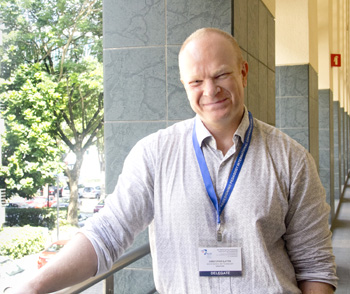Why Singapore’s English Teachers Should Embrace Singlish, Not Fight It
Is it time for Singaporean educators to embrace Singlish as a legitimate learning tool? What the Research […]
Read More
Students should learn by doing – this is the core learning principle at the School of Science and Technology. A Chemistry teacher shares with us the school’s approach, also known as applied learning.
How does one learn to ride a bicycle? Do you read a manual? Attend a lecture? Or even watch a video on riding one? For Mr Christopher Slatter, the answer is simple.
“This is how you learn to ride a bicycle – you get on the bicycle, with someone beside you who has an expertise to ride one,” he says. “That person will encourage and motivate you, and tell you what’s going right and wrong.
“We learn by actually doing it,” Chris continues. It is the same for a subject such as Science.
“Science is a verb,” the Chemistry teacher says. “Science is something we have to do and not just learn from the textbook.”
By using this approach, he believes that his students will leave his classroom thinking like a scientist. That is what applied learning is about in a nutshell – learning by doing.
A group of teachers at SST came together to plan lessons that will allow students to actually do Science in the classroom. Chris says that being able to do Science allows students to demonstrate their level of understanding and what they have learned by transferring their scientific knowledge into real-world contexts.
What the teachers came up with was a variety of lessons that aims to interest and engage their students. Chris shares a few examples of applied learning in his Chemistry classroom.
Inspired by the popular television show CSI, Chris got his students to imagine that the body of a young man had been found at the Marina Bay Golf Course and told them that the cause of death was drowning.
His students turned into crime scene investigators and were given samples of water from the victim’s lungs and also samples from several water bodies. They conducted qualitative analysis of the given samples to identify their anions and cations and used that to determine where the victim drowned. They also had to prepare a forensic science report and submit it to the police, which, in this case, was Chris himself.
To make the learning environment more realistic, Chris says that the science lab was sealed with “Crime Scene Investigation” tapes. “It helps set the context,” he adds. “The students were more engaged than when they do practical worksheets.”

It is a problem all of us know too well – many people from third-world countries have no access to clean drinking water. The students-turn-chemists had to do something about that.
“As a chemist, how can you help this child have access to clean drinking water?” Chris asked them. These “chemists” had to translate their knowledge into actions by analysing the water, and designing a model for a filtration system to purify it.
This lesson also helped students develop stewardship of issues in the community and world at large – it encourages the learners to be more community-focused and aware of global issues.
In this activity, students were a part of a local emergency response team (ERT) that just received a distress call from an overturned tanker.
“The tanker, loaded with a certain chemical, had overturned in an accident near a reservoir,” Chris says. As part of the ERT, students needed to identify the unknown chemical and find out how to neutralize it as quickly as possible.
To create a more challenging situation, Chris, the Chief Scientific Officer, informed the team that a storm was brewing and they had 40 minutes to complete the task. The team must also stop the chemical from leaking into the reservoir.
“This was done online and we gave them the information they need,” Chris shares. “So students were actually at the scene of the accident and as they analysed the data, they discovered new things.”
As part of an assessment, the students submitted a detailed scientific report of their findings to Chris.
At the start of his presentation, Chris showed a quote by astronomer Carl Sagan: “Every kid starts out as a natural born scientist, and then we beat it out of them. A few trickle through the system with their wonder and enthusiasm for science intact.”
He then posed a question to the conference participants: “So how do we prepare and motivate our students today to become scientists and engineers of tomorrow?”
Applied learning may be one of the ways, Chris says. Challenging and real-life context studies, like the ones he presented, enables students to turn their academic knowledge into action. His aim – and ultimately, the school’s aim – is to prepare and motivate students today to become scientists of tomorrow.